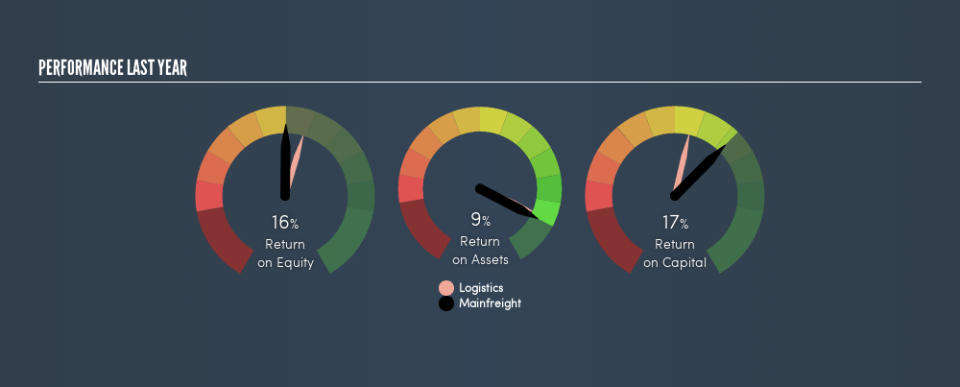Is Mainfreight Limited’s (NZSE:MFT) Return On Capital Employed Any Good?

Want to participate in a research study? Help shape the future of investing tools and earn a $60 gift card!
Today we'll look at Mainfreight Limited (NZSE:MFT) and reflect on its potential as an investment. Specifically, we're going to calculate its Return On Capital Employed (ROCE), in the hopes of getting some insight into the business.
First of all, we'll work out how to calculate ROCE. Then we'll compare its ROCE to similar companies. Then we'll determine how its current liabilities are affecting its ROCE.
Return On Capital Employed (ROCE): What is it?
ROCE is a measure of a company's yearly pre-tax profit (its return), relative to the capital employed in the business. All else being equal, a better business will have a higher ROCE. In brief, it is a useful tool, but it is not without drawbacks. Author Edwin Whiting says to be careful when comparing the ROCE of different businesses, since 'No two businesses are exactly alike.'
So, How Do We Calculate ROCE?
Analysts use this formula to calculate return on capital employed:
Return on Capital Employed = Earnings Before Interest and Tax (EBIT) ÷ (Total Assets - Current Liabilities)
Or for Mainfreight:
0.17 = NZ$184m ÷ (NZ$1.5b - NZ$416m) (Based on the trailing twelve months to September 2018.)
Therefore, Mainfreight has an ROCE of 17%.
View our latest analysis for Mainfreight
Does Mainfreight Have A Good ROCE?
ROCE is commonly used for comparing the performance of similar businesses. We can see Mainfreight's ROCE is around the 18% average reported by the Logistics industry. Regardless of where Mainfreight sits next to its industry, its ROCE in absolute terms appears satisfactory, and this company could be worth a closer look.
Our data shows that Mainfreight currently has an ROCE of 17%, compared to its ROCE of 14% 3 years ago. This makes us think the business might be improving.
When considering ROCE, bear in mind that it reflects the past and does not necessarily predict the future. ROCE can be deceptive for cyclical businesses, as returns can look incredible in boom times, and terribly low in downturns. ROCE is, after all, simply a snap shot of a single year. Future performance is what matters, and you can see analyst predictions in our free report on analyst forecasts for the company.
Mainfreight's Current Liabilities And Their Impact On Its ROCE
Current liabilities are short term bills and invoices that need to be paid in 12 months or less. Due to the way the ROCE equation works, having large bills due in the near term can make it look as though a company has less capital employed, and thus a higher ROCE than usual. To check the impact of this, we calculate if a company has high current liabilities relative to its total assets.
Mainfreight has total liabilities of NZ$416m and total assets of NZ$1.5b. Therefore its current liabilities are equivalent to approximately 28% of its total assets. Low current liabilities are not boosting the ROCE too much.
Our Take On Mainfreight's ROCE
This is good to see, and with a sound ROCE, Mainfreight could be worth a closer look. Of course you might be able to find a better stock than Mainfreight. So you may wish to see this free collection of other companies that have grown earnings strongly.
I will like Mainfreight better if I see some big insider buys. While we wait, check out this free list of growing companies with considerable, recent, insider buying.
We aim to bring you long-term focused research analysis driven by fundamental data. Note that our analysis may not factor in the latest price-sensitive company announcements or qualitative material.
If you spot an error that warrants correction, please contact the editor at editorial-team@simplywallst.com. This article by Simply Wall St is general in nature. It does not constitute a recommendation to buy or sell any stock, and does not take account of your objectives, or your financial situation. Simply Wall St has no position in the stocks mentioned. Thank you for reading.

